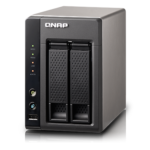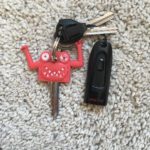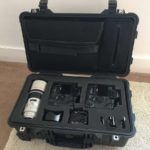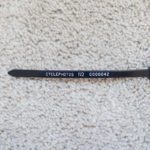Having been travelling extensively in the last couple of years, I grew complacent, when it came to my photo gear’s safety and security. As some of you might know, during our recent trip to Italy with Velofocus, our car was broken into and it was swept clean. The thieves (we gave them names: Claudio and Luigi) took everything, regardless whether it was a camera bag or a suitcase with ten days worth of dirty clothes. The mighty loot included even my favourite t-shirts. What most photographes fear has happened to us, the only light at the end of the tunnel was that at least they didn’t take the gear that was on us. Still, a fair amount of stuff is gone. I wanted to explore what I could have or should have done differently and I thought it would be useful to share the learnings with you, so you don’t have to learn it the hard way, like I did.
-
Before you leave
- Be insured
This sounds obvious, but it can’t hurt to repeat it. Make sure that you have a specialist insurance, that covers expensive items, like cameras – normal travel insurance cover often excludes items costing more than £400. Also, read the small print. I was insured by Hiscox, via Policybee. It seemed to work really well, up until this case. They refused to pay out my claim, saying that the policy says that they won’t pay unless the theft occurred in a locked hotel room. I’m contesting this for a number of reasons, the point is, read the whole policy through and be sure that there are no nasty surprises. One thing to keep an eye out for is Unattended. Different insurers define unattended differently, some cover items left in the boot, some don’t. Read the policy from A to Z. - Data backup strategy
This could be a separate post in itself, here is my strategy in short.
Layer 1 – Home photo backup
 At home, I have a QNAP TS-251 NAS with two 4TB hard drives in there. The NAS is configured to RAID 1
At home, I have a QNAP TS-251 NAS with two 4TB hard drives in there. The NAS is configured to RAID 1
level, which means, that all data on one hard drive is mirrored to the other, so if one drive dies, the other still contains the same data. The ideal solution would be a four-drive NAS, that allows to increase the storage capacity easier with the use of RAID 6, that distributes the data over more drives. This is the first layer. This should prevent data loss from hard drive failure, but it won’t help in case of burglary, fire or flooding.
Layer 2 – Offsite photo backup
 For many years, keeping a lot of data in the cloud wasn’t financially feasible, but prices keep coming down, so it started to make sense. I use Amazon’s Glacier solution. Unlike S3, which is used by a lot of online softwares, this is designed to archive data and not to be accessed often. You will also need a dedicated software to access it – I use Freeze. How did I integrate it my workflow? After every race, when I arrive at home, I upload all the RAW files to Freeze, thus if the NAS fails or is lost, I can retrieve any or all images. It also allows me to occasionally retrieve images remotely while traveling.
For many years, keeping a lot of data in the cloud wasn’t financially feasible, but prices keep coming down, so it started to make sense. I use Amazon’s Glacier solution. Unlike S3, which is used by a lot of online softwares, this is designed to archive data and not to be accessed often. You will also need a dedicated software to access it – I use Freeze. How did I integrate it my workflow? After every race, when I arrive at home, I upload all the RAW files to Freeze, thus if the NAS fails or is lost, I can retrieve any or all images. It also allows me to occasionally retrieve images remotely while traveling.
Layer 2.5 -Â Computer backup
 So far, I’ve touched on backing up the photos, but backing up the hard drive of the computer itself is also important. I use Backblaze, which backs up all my files on my HDD automatically. Automatic back ups are amazing. You might forget manual backups. No, you WILL forget manual backups. And that’s where Backblaze comes in: it backs up everything on your computer, automatically and quietly, in the background. It’s all good and well, but there are two problems with it. First, when I travel, I often don’t have access to fast broadband and consequently, it might happen that files you created whilst traveling (i.e. the photos of a race) might not be fully backed up. Secondly, restoring can be a pain in the backside. For some reason, the download speed from their side during restore is very erratic and downloading 30-40 GB data can take days, which is not very practical, when you have 300 GB more data to retrieve.
So far, I’ve touched on backing up the photos, but backing up the hard drive of the computer itself is also important. I use Backblaze, which backs up all my files on my HDD automatically. Automatic back ups are amazing. You might forget manual backups. No, you WILL forget manual backups. And that’s where Backblaze comes in: it backs up everything on your computer, automatically and quietly, in the background. It’s all good and well, but there are two problems with it. First, when I travel, I often don’t have access to fast broadband and consequently, it might happen that files you created whilst traveling (i.e. the photos of a race) might not be fully backed up. Secondly, restoring can be a pain in the backside. For some reason, the download speed from their side during restore is very erratic and downloading 30-40 GB data can take days, which is not very practical, when you have 300 GB more data to retrieve.
Layer 3 – On-the-go backup
 I used to have a 250GB HDD in my camera bag and I used to back things up on it, but when I bought my new Macbook Pro last summer, I suddenly had a lot of room on my hard drive and I stopped doing that. Not that it would have mattered, because the HDD was in the stolen camera bag, too. I needed something that can be with me at all times. The solutino ended up being a 256 GB USB drive that now lives on my keyring. When I’m on the road, after every day of shooting, I make a Time Machine back up onto this drive. That way, not only do I have a backup of all the photos from that day and from the whole trip, but if the computer is stolen or has a disk failure, I can set up a new computer in a matter of minutes and I wouldn’t have to hunt for plugins, settings and other little things. Admittedly, the whole 500GB won’t fit onto the 256 GB USB drive, but while I could live without music for a few days, until I get home and can retrieve it from Backblaze, I would still be in possession of all my photos. Also, don’t forget to buy a rubber jiggle monster for one of your keys, it helps to scare thieves off. Fact.
I used to have a 250GB HDD in my camera bag and I used to back things up on it, but when I bought my new Macbook Pro last summer, I suddenly had a lot of room on my hard drive and I stopped doing that. Not that it would have mattered, because the HDD was in the stolen camera bag, too. I needed something that can be with me at all times. The solutino ended up being a 256 GB USB drive that now lives on my keyring. When I’m on the road, after every day of shooting, I make a Time Machine back up onto this drive. That way, not only do I have a backup of all the photos from that day and from the whole trip, but if the computer is stolen or has a disk failure, I can set up a new computer in a matter of minutes and I wouldn’t have to hunt for plugins, settings and other little things. Admittedly, the whole 500GB won’t fit onto the 256 GB USB drive, but while I could live without music for a few days, until I get home and can retrieve it from Backblaze, I would still be in possession of all my photos. Also, don’t forget to buy a rubber jiggle monster for one of your keys, it helps to scare thieves off. Fact. - Have an inventory
This is vital for a successful insurance claim. Before each trip, create a list (and save it on Dropbox) of all the items you are taking with you on the trip. Create a one list for camera gear and another list for personal items. It will be a tedious task to list everything for every trip, especially, if you travel as much as I do, but without it, you just won’t know what was in your bag and what can you claim. When you are at the police station, you will be asked what was stolen. You are trying very hard to remember of all the things you had in your bags, professional and personal items, and a comprehensive list that contains the important or expensive items can be very helpful. I guarantee that you will forget something otherwise. - Receipt repository
This is a small thing, but can be pretty helpful when you have to make an insurance claim. Whenever you buy something that goes into your camera bag, take a photo of the receipt and save it in a folder on Dropbox. Also, go back to your records and fish out all the receipts of your current gear. Doing this will help you to make an insurance claim quickly and efficiently, as insurance companies will ask for a proof of purchase. If you add receipts every time you buy new gear, it will allow you to claim for smaller items, too. It might sound too much hassle for, but when you have to replace four 32GB CF cards at £50 each in one go, things get expensive pretty quickly.
- Be insured
-
How to keep your gear safe
- Camera bag
 I used to use a LowePro backpack, which I really liked, until Luigi decided that it belonged to him. As a replacement, I decided to get a Peli 1510 protector case. It’s big enough to hold two Canon 1DX bodies, a two short prime lenses and the smaller, f/4 300mm lens as well, plus my laptop and a few small bits and essentials (card reader, spare batteries, battery chargers, etc.). I opted for a practical, foam grid system, where you just pluck out the shape of your gear and you slot everything in. It took me some time to figure out the perfect setup, but a new set of foam insert is relatively cheap, so if you mess up (like I did), you can start again. However, the case is small enough to be allowed on flights, as it fits within most airline’s carry-on size requirements. The only caveat is that sometimes, on busy flights, they ask passengers with rolling cases to check them in. The case is sturdy, so short of the plane rolling over it, its contents should be safe. How to prevent greedy baggage handlers? That comes next.
I used to use a LowePro backpack, which I really liked, until Luigi decided that it belonged to him. As a replacement, I decided to get a Peli 1510 protector case. It’s big enough to hold two Canon 1DX bodies, a two short prime lenses and the smaller, f/4 300mm lens as well, plus my laptop and a few small bits and essentials (card reader, spare batteries, battery chargers, etc.). I opted for a practical, foam grid system, where you just pluck out the shape of your gear and you slot everything in. It took me some time to figure out the perfect setup, but a new set of foam insert is relatively cheap, so if you mess up (like I did), you can start again. However, the case is small enough to be allowed on flights, as it fits within most airline’s carry-on size requirements. The only caveat is that sometimes, on busy flights, they ask passengers with rolling cases to check them in. The case is sturdy, so short of the plane rolling over it, its contents should be safe. How to prevent greedy baggage handlers? That comes next. - Lock
While the latches of the case itself are quite sturdy, to prevent anybody from opening the bag, I use a padlock. Any padlock will do as no lock can withstand a very determined thief, but it will prevent the opportunist ones from quickly grabbing stuff from your case. - Customised zip ties
 Another line of defence while traveling are customised zip ties. I have made one hundred, customised, black zip ties. They contain the word ‘cyclephotos’ and a unique number. Once you put it on the case, you’ll know if someone tampered with it, because replacing these zip ties would be impossible – which would not be the case if I used generic zip ties.
Another line of defence while traveling are customised zip ties. I have made one hundred, customised, black zip ties. They contain the word ‘cyclephotos’ and a unique number. Once you put it on the case, you’ll know if someone tampered with it, because replacing these zip ties would be impossible – which would not be the case if I used generic zip ties. - Kryptoflex cable
I’ve bought this cable a few years back, it came bundled with a bike lock. In combination with the lock I can secure my Peli case to objects in a car, at a press centre or in a hotel room. As most things, it won’t stop the most dedicated thieves, but it will stop a quick grab and might withstand some force, too.
- Camera bag
-
When trouble occurs
- Stay calm
- Get a police report
Without it, insurers won’t accept your claims. Use your inventory to make sure that you have everything listed in the police report. Some insurance companies require you to notify them immediately. Even if they don’t have a open claim line during the weekend, it makes sense to fire over an email to let them know what happened.
Do you have any further tips on gear safety or security? Let me know in the comments.


2 comments
As Italian, I apologize to you. I’m really sorry for what happened.
Best whishes and best regards.
Bye
Thanks Francesco, I appreciate it, but there is really no need for that – it could have happened anywhere else.
Comments are closed.